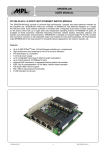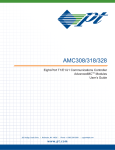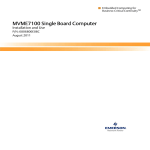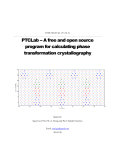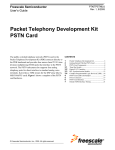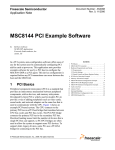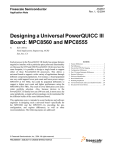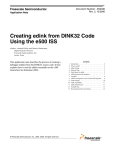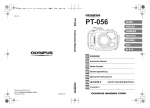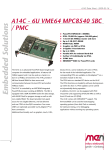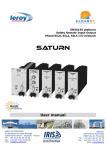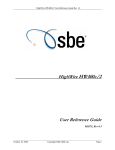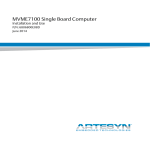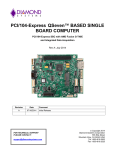Download NPCIe-8560-8E1/T1/J1
Transcript
NPCIe-8560-8E1/T1/J1 – Technical Reference Manual NPCIe-8560-8E1/T1/J1 Telecom PCIe Module Technical Reference Manual V1.2 HW Revision 1.0 NPCIe-8560-8E1/T1/J1 – Technical Reference Manual The NPCIe-8560-8E1/T1/J1 has been designed by: N.A.T. GmbH Konrad-Zuse-Platz 9 D-53227 Bonn Phone: +49 / 228 / 965 864 - 0 Fax: +49 /228 / 965 864 - 10 Internet: http://www.nateurope.com Version 1.2 © N.A.T. GmbH 2 NPCIe-8560-8E1/T1/J1 – Technical Reference Manual Disclaimer The following documentation, compiled by N.A.T. GmbH (henceforth called N.A.T.), represents the current status of the product´s development. The documentation is updated on a regular basis. Any changes which might ensue, including those necessitated by updated specifications, are considered in the latest version of this documentation. N.A.T. is under no obligation to notify any person, organization, or institution of such changes or to make these changes public in any other way. We must caution you, that this publication could include technical inaccuracies or typographical errors. N.A.T. offers no warranty, either expressed or implied, for the contents of this documentation or for the product described therein, including but not limited to the warranties of merchantability or the fitness of the product for any specific purpose. In no event will N.A.T. be liable for any loss of data or for errors in data utilization or processing resulting from the use of this product or the documentation. In particular, N.A.T. will not be responsible for any direct or indirect damages (including lost profits, lost savings, delays or interruptions in the flow of business activities, including but not limited to, special, incidental, consequential, or other similar damages) arising out of the use of or inability to use this product or the associated documentation, even if N.A.T. or any authorized N.A.T. representative has been advised of the possibility of such damages. The use of registered names, trademarks, etc. in this publication does not imply, even in the absence of a specific statement, that such names are exempt from the relevant protective laws and regulations (patent laws, trade mark laws, etc.) and therefore free for general use. In no case does N.A.T. guarantee that the information given in this documentation is free of such third-party rights. Neither this documentation nor any part thereof may be copied, translated, or reduced to any electronic medium or machine form without the prior written consent from N.A.T. GmbH. This product (and the associated documentation) is governed by the N.A.T. General Conditions and Terms of Delivery and Payment. Note: The release of the Hardware Manual is related to a certain HW board revision given in the document title. For HW revisions earlier than the one given in the document title please contact N.A.T. for the corresponding older Hardware Manual release. Version 1.2 © N.A.T. GmbH 3 NPCIe-8560-8E1/T1/J1 – Technical Reference Manual Table of Contents TABLE OF CONTENTS .......................................................................................... 4 LIST OF TABLES .................................................................................................. 5 LIST OF FIGURES ................................................................................................ 5 CONVENTIONS .................................................................................................... 6 1 INTRODUCTION ........................................................................................... 7 2 OVERVIEW ................................................................................................... 8 2.1 2.2 2.3 3 MAJOR FEATURES ........................................................................................ 8 BLOCK DIAGRAM ......................................................................................... 9 LOCATION OVERVIEW ..................................................................................10 BOARD FEATURES ...................................................................................... 11 3.1 CPU ......................................................................................................11 3.1.1 Processor Core .................................................................................11 3.1.2 Processor – Integrated I/O ................................................................11 3.2 MEMORY ..................................................................................................12 3.2.1 DDR SDRAM ....................................................................................12 3.2.2 FLASH .............................................................................................12 3.3 PCI EXPRESS INTERFACE ..............................................................................12 3.4 E1/T1/J1 LINE INTERFACES ..........................................................................12 3.5 ETHERNET ................................................................................................12 3.6 PTMC INTERFACE .......................................................................................13 3.7 ITDM .....................................................................................................13 3.8 I2C DEVICES.............................................................................................13 4 HARDWARE ................................................................................................ 14 4.1 FRONT PANEL AND LEDS ..............................................................................14 4.2 CONNECTORS AND SWITCHES .........................................................................15 4.2.1 P1: PCI Express Connector ................................................................16 4.2.2 S1: Ethernet Connector .....................................................................16 4.2.3 S3: ISDN Connector .........................................................................17 4.2.4 JP1: Lattice Programming Port ...........................................................18 4.2.5 JP2: BDM and JTAG Connector ...........................................................18 4.2.6 P11/P12: PMC Connectors .................................................................19 4.2.7 P13: PMC Connector .........................................................................20 4.2.8 P14: PMC Connector – Configuration 2/3 .............................................21 4.2.9 S2: RS232 Connector ........................................................................22 4.2.10 DIP SW1: Flash Half Select / PCIe Bridge Direction ...............................22 4.2.10.1 DIP SW1: Switch 1 – Boot FLASH Select Switch .............................22 4.2.10.2 DIP SW1: Switch 2 – PCIe Bridge Direction Switch .........................23 4.2.11 LF1: Write-Protect-Pin – Solder Field...................................................23 4.2.12 LF2: Voltage Source – Solder Field .....................................................23 5 NPCIE-8560-8E1/T1/J1 PROGRAMMING NOTES ........................................ 24 6 BOARD SPECIFICATION ............................................................................. 25 Version 1.2 © N.A.T. GmbH 4 NPCIe-8560-8E1/T1/J1 – Technical Reference Manual 7 INSTALLATION .......................................................................................... 26 7.1 SAFETY NOTE ............................................................................................26 7.2 INSTALLATION PREREQUISITES AND REQUIREMENTS ...............................................27 7.2.1 Requirements ..................................................................................27 7.2.2 Power supply ...................................................................................27 7.2.3 Automatic Power Up..........................................................................27 7.2.4 Thermal Considerations .....................................................................27 7.3 STATEMENT ON ENVIRONMENTAL PROTECTION .....................................................28 7.3.1 Compliance to RoHS Directive ............................................................28 7.3.2 Compliance to WEEE Directive ............................................................28 7.3.3 Compliance to CE Directive ................................................................29 7.3.4 Product Safety .................................................................................29 8 KNOWN BUGS / RESTRICTIONS ................................................................. 30 APPENDIX A: REFERENCE DOCUMENTATION .................................................... 31 APPENDIX B: DOCUMENT’S HISTORY ............................................................... 32 List of Tables Table Table Table Table Table Table Table Table Table Table Table Table Table Table Table Table Table 1: 2: 3: 4: 5: 6: 7: 8: 9: 10: 11: 12: 13: 14: 15: 16: 17: List of used abbreviations ...................................................................... 6 P1: PCIe Connector – Pin Assignment .....................................................16 S1: Ethernet Connector – Pin Assignment ...............................................16 S3a: ISDN Connector – Pin Assignment ..................................................17 S3b: ISDN Connector – Pin Assignment ..................................................17 S3c: ISDN Connector – Pin Assignment ..................................................17 S3d: ISDN Connector – Pin Assignment ..................................................17 JP1: Lattice Programming Port – Pin Assignment .....................................18 JP2: BDM and JTAG Connector – Pin Assignment .....................................18 P11/P12: PMC Connectors – Pin Assignment............................................19 P13: PMC Connector – Pin Assignment ...................................................20 P14: PMC Connector – Configuration 2/3 – Pin Assignment .......................21 S2: RS232 Connector – Pin Assignment ..................................................22 DIP SW1: Pin Assignment - Overview .....................................................22 DIP SW1: Switch 1 – Boot Flash Select – Pin Assignment ..........................22 DIP SW1: Switch 2 – PCIe Bridge Direction – Pin Assignment ....................23 NPCIe-8560-8E1/T1/J1 – Features .........................................................25 List of Figures Figure Figure Figure Figure 1: 2: 3: 4: Version 1.2 NPCIe-8560-8E1/T1/J1– Block Diagram - Overview .................................. 9 NPCIe-8560-8E1/T1/J1 – Location diagram – Overview ............................10 NPCIe-8560-8E1/T1/J1 – Front Panel View ..............................................14 NPCIe-8560-8E1/T1/J1 – Connector and Switch location – Overview ..........15 © N.A.T. GmbH 5 NPCIe-8560-8E1/T1/J1 – Technical Reference Manual Conventions If not otherwise specified, addresses and memory maps are written in hexadecimal notation, identified by 0x. The following table gives a list of the abbreviations used in this document. Table 1: List of used abbreviations Abbreviation Description b B CPLD CPU DDR DMA DRAM E1 FLASH FPGA iTDM J1 LIU MPC8560 PCIe PCI-X PowerQUICC III RAM ROM SCbus SCC SCSA SDRAM SMC T1 TDM TSI TSA Bit, binary Byte Complex Programmable Logic Device Central Processing Unit Dual Data Rate Direct Memory Access Dynamic RAM 2.048 Mbit G.703 Interface Reprogrammable ROM Field Programmable Gate Array internal TDM 1,544 Mbit G.703 Interface (Japan) Line Interface Unit Embedded Processor from Freescale PCI Express Extended PCI MPC8560 Random Access Memory Read Only Memory Time-Slot Interchange Bus of the SCSA, subset of H.110 bus Serial Communication Controller of the MPC8560 Signal Computing System Architecture Synchronous Dynamic RAM Serial Communication Controller of the MPC8560 1,544 Mbit G.703 Interface (USA) Time Division Multiplex Time Slot Interchange Time Slot Assigner Version 1.2 © N.A.T. GmbH 6 NPCIe-8560-8E1/T1/J1 – Technical Reference Manual 1 Introduction The NPCIe-8560-8E1/T1/J1 is a high performance standard height, full length PCI Express x1 add-in card. The NPCIe-8560-8E1/T1/J1 is providing access to E1/T1/J1 interfaces combined with the functionality of a PMC carrier board. It is intended to be used with standard PMC or PTMC modules in a standard PC with PCI Express extension slots. Version 1.2 © N.A.T. GmbH 7 NPCIe-8560-8E1/T1/J1 – Technical Reference Manual 2 Overview 2.1 Major Features PowerQUICC III MPC8560 based Embedded PowerPC Architecture 128 MB main Memory (DDR SDRAM) 16 – 64 MB FLASH (default: 32MB) x1 PCI Express Interface Rev. 1.1 8x E1 / T1 / J1 Primary Rate Line Interface 1000BaseT Ethernet channel on Front Panel iTDM Interface PTMC Interface for configuration 2/3: 32 bit PCI bus CT bus Ethernet RS232 serial I/O Version 1.2 © N.A.T. GmbH 8 NPCIe-8560-8E1/T1/J1 – Technical Reference Manual 2.2 Block Diagram The following figure shows a block diagram of the NPCIe-8560-8E1/T1/J1. PCIe to PCI bridge PCIe x1 GbE PHY 1GbE Ethernet PTMC connectors J1 and J2 NPCIe-8560-8E1/T1/J1– Block Diagram - Overview PCI 32 bit Temp. Sensor GMII RTC I2C MPC8560 833MHz RMII (PTMC CFG 2) or MIDI (PTMC CFG5) CPU DDR bus 64bit PowerQUICC3TM eTSEC1 Face Plate 128-256MB DDR SDRAM 333MHz GbE FPGA Lattice ECP3 PTMC connector J3 (CFG 2) or (design option) PTMC connector J4 (CFG 5) PCIe x1 Connector Figure 1: PTMC site (CFG 2 or 5) 16-64MB FLASH Local Bus CT Bus (H.110) E1/T1/J1 1/2 E1/T1/J1 3/4 E1/T1/J1 5/6 Maxim Octal E1 Framer DS26518 TDM Bus PLL Zarlink ZL30100 PTMC connector J3 RS232 Console Reference clock signals E1/T1/J1 7/8 SPI SPI M U X SPI FLASH Version 1.2 © N.A.T. GmbH 9 NPCIe-8560-8E1/T1/J1 – Technical Reference Manual 2.3 Location Overview The position of important components is shown in the following location overview. Depending on the board type it might be that the board does not include all components named in the location diagram. Figure 2: Version 1.2 NPCIe-8560-8E1/T1/J1 – Location diagram – Overview © N.A.T. GmbH 10 NPCIe-8560-8E1/T1/J1 – Technical Reference Manual 3 Board Features The NPCIe-8560-8E1/T1/J1 can be divided into a number of functional blocks, which are described in the following paragraphs. 3.1 CPU 3.1.1 Processor Core The MPC8560 PowerQUICC III™ is a versatile communications processor that integrates on one chip a high-performance PowerPC™ RISC microprocessor running at 833MHz, a very flexible system integration unit and many communications peripheral controllers that can be used in a variety of applications, particularly in communications and networking systems. The core is an embedded variant of the PowerPC e500™ core with 32 Kbytes of instruction cache and 32 Kbytes of data cache. To this primary cache adds 256 Kbytes of Level 2 cache. The system interface unit (SIU) consists of a flexible memory controller that interfaces to almost any user-defined memory system and many other peripherals making this device a complete system on a chip. 3.1.2 Processor – Integrated I/O The MPC8560 PowerQUICC III™ integrates a switch fabric and 2 10/100/1000 MB MACs, which support various standard protocols. The communications processor module (CPM) includes four serial communications controllers (SCCs), with the addition of three high-performance communication channels that support new emerging protocols (for example, 155 Mbps ATM and Fast Ethernet). The CPM frequency may be set up to 333 MHz. The MPC8560 features dedicated hardware that can handle up to 256 full-duplex, time-division-multiplexed logical channels, as well as DMA functionality executing memory to memory and memory to I/O transfers. Furthermore the MPC8560 integrates a 64 bit PCI / PCI-X interface, and a 4channel DMA controller. Version 1.2 © N.A.T. GmbH 11 NPCIe-8560-8E1/T1/J1 – Technical Reference Manual 3.2 Memory 3.2.1 DDR SDRAM The onboard DDR SDRAM memory is 64 bit wide; its size is 128MB. The interface to the DDR SDRAM is implemented in the MPC8560. By programming several registers the DDR RAM controller can be adapted to different RAM architectures. 3.2.2 FLASH The NPCIe-8560-8E1/T1/J1 provides a 16 bit wide FLASH PROM with a capacity of 16 - 64MB (assembly option, default: 32MB). This memory is connected to the demultiplexed upper 16 data bits D0 – 15 and to the latched address lines. Demultiplexing of the local address/data bus of the CPU, as well as address latching, is performed by an FPGA. The FLASH PROM can be programmed either by the CPU (by appropriate software or through the BDM port) or by a PCI bus master. 3.3 PCI Express Interface The NPCIe-8560-8E1/T1/J1 includes a x1 PCI Express interface which is implemented in a PEX8111 PCI-X to PCIe bridge (PLX). The PCI Express interface is connected directly to the PCI Express connector whereas the PCI interface is connected to the MPC8560 CPU and the PMC connector. The PCIe bridge may receive its reference clock either from the PCIe connector or from a local 100 MHz oscillator circuitry; the clock source is programmable. 3.4 E1/T1/J1 Line Interfaces The NPCIe-8560-8E1/T1/J1 carries a Maxim DS26518 framer, which implements eight E1/T1/J1 interfaces. These interfaces connect the framer to the front panel RJ45 connector S3. Timing and interface characteristics can be set up by software within the DS26518. The line interfaces conform to EN60950 and G.703 / G.823 (Jitter Attenuation). The front panel RJ45 connector S3 consists of 4 RJ45 jacks with integrated LEDs. In order to support 8 E1/T1/J1 interfaces each RJ45 jack carries 2 E1/T1/J1 interfaces. The LEDs are bi-colored and programmable through registers which reside within the FPGA. 3.5 Ethernet The NPCIe-8560-8E1/T1/J1 implements a Gigabit Ethernet interface (1000Base-T) at the front panel that is connected to the onboard FPGA. All other onboard devices are connected to the same FPGA, which implements a HUB functionality that allows all devices to access the front interface. The connected devices are the TSEC Ethernet MAC of the MPC8560 CPU as well as the PMC/PTMC (connected to the FPGA via RMII) and the iTDM block implemented in the FPGA. (The PMC is only connected via a 100MBit interface.) The Broadcom BCM5461 Ethernet PHY is connected to the FPGA via GMII interface. It connects to the front panel connector S1. Version 1.2 © N.A.T. GmbH 12 NPCIe-8560-8E1/T1/J1 – Technical Reference Manual 3.6 PTMC Interface The NPCIe-8560-8E1/T1/J1 implements a CT-Bus (H.110) that connects to the PMC connector. 3.7 iTDM The NPCIe-8560-8E1/T1/J1 implements a serial iTDM interface based on Ethernet. The iTDM Block (implemented in the FPGA) has also access to the Ethernet Hub block. Therefore the iTDM Block can transfer data through the same physical ports that connects to the front panel interface or the PTMC. The iTDM interface conforms to the SFP.0 and SFP.1 specifications. 3.8 I2C Devices The NPCIe-8560-8E1/T1/J1 features an I²C link which is connected to the MPC8560 I2C interface and to a couple of local devices. The following devices are connected: An EEPROM for storage of board-specific information (24C08) A temperature sensor (LM75) which is located near the MPC8560 CPU to sense the processor temperature A real time clock device (DS1339C) Version 1.2 © N.A.T. GmbH 13 NPCIe-8560-8E1/T1/J1 – Technical Reference Manual 4 Hardware 4.1 Front Panel and LEDs The following figures shows the LEDs placed on the front panel of the NPCIe-85608E1/T1/J1. Figure 3: NPCIe-8560-8E1/T1/J1 – Front Panel View S1 LED1 S3d S3c S3b S3a LED2 The NPCIe-8560-8E1/T1/J1 module is equipped with 2 LEDs, which are controlled by the Ethernet PHY. They are integrated in the RJ45 Ethernet interface jack. LED1 is showing the link status and LED2 shows the activity. Please refer to Chapter 4.2 for detailed information about the front panel connectors. Version 1.2 © N.A.T. GmbH 14 NPCIe-8560-8E1/T1/J1 – Technical Reference Manual 4.2 Connectors and Switches Figure 4: NPCIe-8560-8E1/T1/J1 – Connector and Switch location – Overview Please refer to the following sub-chapters to look up the connector pin assignment of the NPCIe-8560-8E1/T1/J1. Version 1.2 © N.A.T. GmbH 15 NPCIe-8560-8E1/T1/J1 – Technical Reference Manual 4.2.1 P1: PCI Express Connector P1 is a standard PCIe x1 connector. Table 2: P1: PCIe Connector – Pin Assignment Pin # Signal Signal Pin # A1 A2 A3 A4 A5 A6 A7 A8 A9 A10 A11 A12 A13 A14 A15 A16 A17 A18 PRSNT1# +12V +12V GND TCK TDI TDO TMS +3.3V +3.3V /PERST GND REFCLK+ REFCLKGND PERp0 PERn0 GND +12V +12V +12V GND SMCLK SMDAT GND +3.3V TRST# +3.3Vaux WAKE# NC GND PETp0 PETn0 GND PRSNT2# GND B1 B2 B3 B4 B5 B6 B7 B8 B9 B10 B11 B12 B13 B14 B15 B16 B17 B18 4.2.2 S1: Ethernet Connector The following table shows the pin assignment of RJ45-connector S1. This connector carries the 1000BaseT signals of the Ethernet interface. Table 3: S1: Ethernet Connector – Pin Assignment Pin # Signal Signal Pin # 1 3 5 7 MX0+ MX1+ MX2MX3+ MX0MX2+ MX1MX3- 2 4 6 8 Version 1.2 © N.A.T. GmbH 16 NPCIe-8560-8E1/T1/J1 – Technical Reference Manual 4.2.3 S3: ISDN Connector The ISDN front panel connectors are 8-pin RJ45 connectors. The 8 E1/T1/J1 line interfaces are available on the pins of the front panel connectors S3a – S3d; each connector carries two interfaces. The following tables show the pin assignments. Table 4: S3a: ISDN Connector – Pin Assignment Pin # Signal Signal Pin # 1 3 5 7 RX7+ RX8+ TX7TX8+ RX7TX7+ RX8TX8- 2 4 6 8 Table 5: S3b: ISDN Connector – Pin Assignment Pin # Signal Signal Pin # 1 3 5 7 RX5+ RX6+ TX5TX6+ RX5TX5+ RX6TX6- 2 4 6 8 Table 6: S3c: ISDN Connector – Pin Assignment Pin # Signal Signal Pin # 1 3 5 7 RX3+ RX4+ TX3TX4+ RX3TX3+ RX4TX4- 2 4 6 8 Table 7: S3d: ISDN Connector – Pin Assignment Pin # Signal Signal Pin # 1 3 5 7 RX1+ RX2+ TX1TX2+ RX1TX1+ RX2TX2- 2 4 6 8 Version 1.2 © N.A.T. GmbH 17 NPCIe-8560-8E1/T1/J1 – Technical Reference Manual 4.2.4 JP1: Lattice Programming Port Connector JP1 connects the JTAG- or programming port of the Lattice FPGA devices. Table 8: JP1: Lattice Programming Port – Pin Assignment Pin # Signal Signal Pin # 1 3 5 7 9 3.3V TDI NC GND DONE TDO /PROGRAMN TMS TCK INITN 2 4 6 8 10 4.2.5 JP2: BDM and JTAG Connector The BDM port (also called COP header) can be used for debugging. It is supported by major debug tool manufacturers. Table 9: JP2: BDM and JTAG Connector – Pin Assignment Pin # Signal Signal Pin # 1 3 5 7 9 11 13 15 TDO TDI 10K PU to +3.3V TCK TMS /SRESET /HRESET /CKSTP_OUT nc /TRST 2K PU to+3.3V /CKSTP_IN nc nc nc GND 2 4 6 8 10 12 14 16 Version 1.2 © N.A.T. GmbH 18 NPCIe-8560-8E1/T1/J1 – Technical Reference Manual 4.2.6 P11/P12: PMC Connectors Table 10: P11/P12: PMC Connectors – Pin Assignment P11 P12 Pin # Signal Signal Pin # Pin # Signal Signal Pin # 1 3 5 7 9 11 13 15 17 19 21 23 25 27 29 31 33 35 37 39 41 43 45 47 49 51 53 55 57 59 61 63 TCK GND INTB# NC INTD# GND CLK GND REQ# V(I/O) AD[28] AD[25] GND AD[22] AD[19] V(I/O) FRAME# GND DEVSEL# GND PCI-RSVD PAR V(I/O) AD[12] AD[09] GND AD[06] AD[04] V(I/O) AD[02] AD[00] GND -12V INTA# INTC# +5V PMC-RSVD NC GND GNT# +5V AD[31] AD[27] GND C/BE[3]# AD[21] +5V AD[17] GND IRDY# +5V LOCK# PMC-RSVD GND AD[15] AD[11] +5V C/BE[0]# AD[05] GND AD[03] AD[01] +5V REQ64# 2 4 6 8 10 12 14 16 18 20 22 24 26 28 30 32 34 36 38 40 42 44 46 48 50 52 54 56 58 60 62 64 1 3 5 7 9 11 13 15 17 19 21 23 25 27 29 31 33 35 37 39 41 43 45 47 49 51 53 55 57 59 61 63 +12V TMS TDI GND PMC-RSVD NC RST# 3.3V PME# AD[30] GND AD[24] IDSEL +3.3V AD[18] AD[16] GND TRDY# GND PERR# +3.3V C/BE[1]# AD[14] M66EN AD[08] AD[07] +3.3V PMC-RSVD PMC-RSVD GND ACK64# GND TRST# TDO GND PMC-RSVD PMC-RSVD +3.3V NC NC GND AD[29] AD[26] +3.3V AD[23] AD[20] GND C/BE[2]# PMC-RSVD +3.3V STOP# GND SERR# GND AD[13] AD[10] +3.3V PMC-RSVD PMC-RSVD GND PMC-RSVD PMC-RSVD +3.3V PMC-RSVD 2 4 6 8 10 12 14 16 18 20 22 24 26 28 30 32 34 36 38 40 42 44 46 48 50 52 54 56 58 60 62 64 Version 1.2 © N.A.T. GmbH 19 NPCIe-8560-8E1/T1/J1 – Technical Reference Manual 4.2.7 P13: PMC Connector Table 11: P13: PMC Connector – Pin Assignment Pin # Signal Signal Pin # 1 3 5 7 9 11 13 15 17 19 21 23 25 27 29 31 33 35 37 39 41 43 45 47 49 51 53 55 57 59 61 63 MDIO GND MDC RXER PTID2 PTGNDZ REFCLK GND CT_FA CT_FB PTID0 PTGNDZ CT_C8A GND CT_D18 CT_D16 GND CT_D14 CT_D12 PTENB# PTGNDZ CT_C8B GND CT_D10 CT_D8 GND CT_D6 CT_D4 PTID1 CT_D2 CT_D0 GND GND STX SRX GND TXD0 TXD1 GND RXD0 RXD1 GND TXEN CAS_DV GND CT_D19 CT_D17 GND NETREF2 USER1Z GND USER2Z NETREF1 GND CT_D15 CT_D13 CT_D11 CT_D9 CT_D7 GND CT_D5 CT_D3 GND CT_D1 2 4 6 8 10 12 14 16 18 20 22 24 26 28 30 32 34 36 38 40 42 44 46 48 50 52 54 56 58 60 62 64 Version 1.2 © N.A.T. GmbH 20 NPCIe-8560-8E1/T1/J1 – Technical Reference Manual 4.2.8 P14: PMC Connector – Configuration 2/3 Table 12: Pin # P14: PMC Connector – Configuration 2/3 – Pin Assignment P14 (Configuration 2) Signal Signal Pin # 1 3 5 7 9 11 13 15 17 19 21 23 25 27 29 31 33 35 37 39 41 43 45 47 49 51 53 55 57 59 61 63 USER USER USER USER USER USER USER USER USER USER USER USER USER USER USER USER USER USER USER USER USER USER USER USER USER USER USER USER USER USER USER USER USER USER USER USER USER USER USER USER USER USER USER USER USER USER USER USER USER USER USER USER USER USER USER USER USER USER USER USER USER USER USER USER 2 4 6 8 10 12 14 16 18 20 22 24 26 28 30 32 34 36 38 40 42 44 46 48 50 52 54 56 58 60 62 64 Pin # 1 3 5 7 9 11 13 15 17 19 21 23 25 27 29 31 33 35 37 39 41 43 45 47 49 51 53 55 57 59 61 63 P14 (Configuration 3) Signal Signal Pin # TxSOC GND TXCLAV RXADR3 USER GND TXREF GND TXADR3 TXADR2 USER GND TXCLK GND TXADR0 TXPRTY GND TXD7 TXD6 USER GND RXCLK GND TXD5 TXD4 GND +TXD3 TXD2 USER TXD1 TXD0 GND GND RXADR4 TXADR4 GND GND RXREF GND RXENB# RXCLAV GND TXENB# RXADR2 GND TXADR1 RXADR1 GND RXADR0 RXPRTY GND RXD7 RXD6 GND RXD5 RXD6 GND RXD3 RXD2 GND RXD1 RXD0 GND RxSOC 2 4 6 8 10 12 14 16 18 20 22 24 26 28 30 32 34 36 38 40 42 44 46 48 50 52 54 56 58 60 62 64 For configuration 2 the PTMC Specification does not define a fixed usage for the PINS marked with USER. These pins are connected to the FPGA on the NPCIe8560-8E1/T1/J1. Please contact NAT if a user defined usage of those pins is needed! Version 1.2 © N.A.T. GmbH 21 NPCIe-8560-8E1/T1/J1 – Technical Reference Manual 4.2.9 S2: RS232 Connector The following table shows the pin assignment of the RS232 interface. Table 13: S2: RS232 Connector – Pin Assignment Pin # Signal Signal Pin # 1 3 5 NC TxD_SCC1 GND RxD_SCC1 NC 2 4 Connector S2 is connected to SCC1 of the MPC8560 CPM. 4.2.10 DIP SW1: Flash Half Select / PCIe Bridge Direction The table below gives an overview of the operating parameters configurable via DIP SW1. Details are given in the following subchapters. Table 14: DIP SW1: Pin Assignment - Overview Switch # Function 1 2 FLASH half select PCIe Bridge Direction 4.2.10.1 DIP SW1: Switch 1 – Boot FLASH Select Switch By operating Switch 1 of DIP SW1 to ON, the upper half of the Boot FLASH is selected for booting. If Switch 1 of DIP SW1 is turned to OFF, the lower half of the Boot FLASH is selected for booting. Table 15: DIP SW1: Switch 1 – Boot Flash Select – Pin Assignment DIP SW1 – Switch 1 Function Upper FLASH Half 1 2 Lower FLASH Half 1 2 Default: Switch 1 of DIP SW1 is toggled to OFF, lower half of the Boot FLASH is selected for booting. Version 1.2 © N.A.T. GmbH 22 NPCIe-8560-8E1/T1/J1 – Technical Reference Manual 4.2.10.2 DIP SW1: Switch 2 – PCIe Bridge Direction Switch This switch is used to select the source of the PCIe reference clock. If Switch 2 of DIP SW1 is turned to ON a local 100MHz reference is chosen. Additionally the PCI reset from the PEX8112 has no longer impact on the rest of the board. This mode is intended to be selected when the board is used in a standalone application. If Switch 2 of DIP SW1 is turned to OFF the external reference clock from the PCIe connector is taken. Table 16: DIP SW1: Switch 2 – PCIe Bridge Direction – Pin Assignment DIP SW1 – Switch 2 Function Local 100MHz Clock 1 2 1 2 External Clock from PCIe Connector Default: Switch 2 of DIP SW1 is switched to OFF, external clock from PCIe connector selected 4.2.11 LF1: Write-Protect-Pin – Solder Field If the solder field LF1 is closed the Write-Protect-Pin (WP-Pin) of the FLASH is asserted. Default: Solder field LF1 is open, FLASH write protection is disabled. 4.2.12 LF2: Voltage Source – Solder Field Solder field LF2 selects the source of the PMC +3.3VAUX. If the solder field is closed towards the mark on the PCB “3.3V AUX”, the +3.3V AUX of the PMC is directly connected to the +3.3VAUX of the PCIe connector. If the solder field is closed to the other side the +3.3VAUX of the PMC is sourced by the local generated +3.3V. Default: Solder field LF2 is closed towards the mark “3.3V AUX”, the PMC +3.3V AUX is sourced by the local generated +3.3V. Version 1.2 © N.A.T. GmbH 23 NPCIe-8560-8E1/T1/J1 – Technical Reference Manual 5 NPCIe-8560-8E1/T1/J1 Programming Notes TBD Note: This chapter will be completed in a later version of the User’s Manual. For the time being, contact N.A.T. for further assistance on programming. Version 1.2 © N.A.T. GmbH 24 NPCIe-8560-8E1/T1/J1 – Technical Reference Manual 6 Board Specification Table 17: NPCIe-8560-8E1/T1/J1 – Features Processor PCI Express Module Front-I/O Main Memory FLASH PROM Firmware Power Consumption (MPC8560 / 833MHz) Operating Temperature Storage Temperature Humidity Standards compliance Version 1.2 PowerQUICC III MPC8560 (833MHz) based Embedded PowerPC Architecture Standard height, full length PCI Express x1 add-in card (111.15mm x 312.00mm) 5x RJ45 connectors 128MB DDR SDRAM 16 – 64MB FLASH PROM – on board programmable OK1, LINUX BSP (on request) 12V 2.0A max. 0°C – +65°C with forced cooling -40°C - +85°C 10% – 90% rh non-condensing PCI Express Base Specification Rev. 1.1 PCI Express CEM Specification Rev. 1.1 PICMG 2.15 Rev. 1.0 ITU-T G.703 (for E1/T1 Standard) ITU-T G.823 (Jitter Attenuation) © N.A.T. GmbH 25 NPCIe-8560-8E1/T1/J1 – Technical Reference Manual 7 Installation 7.1 Safety Note To ensure proper functioning of the NPCIe-8560-8E1/T1/J1 during its usual lifetime take the following precautions before handling the board. CAUTION Electrostatic discharge and incorrect board installation and uninstallation can damage circuits or shorten their lifetime. Before installing or uninstalling the NPCIe-8560-8E1/T1/J1 read this installation section Before installing or uninstalling the NPCIe-8560-8E1/T1/J1, read the Installation Guide and the User’s Manual of the PC/Server main board used, or of the PCIe system the board will be plugged into. Before installing or uninstalling the NPCIe-8560-8E1/T1/J1 switch off the power. Before touching integrated circuits ensure to take all require precautions for handling electrostatic devices. Ensure that the NPCIe-8560-8E1/T1/J1 is connected to the main board or to the PCIe backplane with the connector completely inserted. When operating the board in areas of strong electromagnetic radiation ensure that the module is bolted the front panel or rack and shielded by closed housing Version 1.2 © N.A.T. GmbH 26 NPCIe-8560-8E1/T1/J1 – Technical Reference Manual 7.2 Installation Prerequisites and Requirements IMPORTANT Before powering up check this section for installation prerequisites and requirements! 7.2.1 Requirements The installation requires only an PCIe main board or a PCIe backplane for connecting the NPCIe-85608E1/T1/J1 7.2.2 Power supply The power supply for the NPCIe-8560-8E1/T1/J1 must meet the following specifications: Required for the NPCIe-8560-8E1/T1/J1: +12V / 1.1A typ. +3.3V / 0.9A typ. Required for the PMC Module +3.3Vaux / can be connected to 3.3aux of the PMC via LF2 or it can be connected to the local generated +3.3V for the PMC. All other PMC Power supplies (+12V, +5V, +3.3V, -12V) are locally generated out of the +12V from the PCIe connector. That means the complete power that is needed by the PMC will be added to the +12V line of the PCIe connector! 7.2.3 Automatic Power Up In the following situations the NPCIe-8560-8E1/T1/J1 will automatically be reset and proceed with a normal power up: The voltage sensor generates a reset when +12V voltage level drops below 8V when +3.3V voltage level drops below 3.08V The main board / backplane signals a PCIe Reset. 7.2.4 Thermal Considerations The NPCIe-8560-8E1/T1/J1 can be operated in a temperature range of 0°C to +65°C if the air velocity does not fall below 1 m/s. This minimum velocity is required in the region of the CPU’s heat sink, the residual area should be passed by air with a minimum velocity of 0.5 m/s. Version 1.2 © N.A.T. GmbH 27 NPCIe-8560-8E1/T1/J1 – Technical Reference Manual 7.3 Statement on Environmental Protection 7.3.1 Compliance to RoHS Directive Directive 2002/95/EC of the European Commission on the "Restriction of the use of certain Hazardous Substances in Electrical and Electronic Equipment" (RoHS) predicts that all electrical and electronic equipment being put on the European market after June 30th, 2006 must contain lead, mercury, hexavalent chromium, polybrominated biphenyls (PBB) and polybrominated diphenyl ethers (PBDE) and cadmium in maximum concentration values of 0.1% respective 0.01% by weight in homogenous materials only. As these hazardous substances are currently used with semiconductors, plastics (i.e. semiconductor packages, connectors) and soldering tin any hardware product is affected by the RoHS directive if it does not belong to one of the groups of products exempted from the RoHS directive. Although many of hardware products of N.A.T. are exempted from the RoHS directive it is a declared policy of N.A.T. to provide all products fully compliant to the RoHS directive as soon as possible. For this purpose since January 31st, 2005 N.A.T. is requesting RoHS compliant deliveries from its suppliers. Special attention and care has been paid to the production cycle, so that wherever and whenever possible RoHS components are used with N.A.T. hardware products already. 7.3.2 Compliance to WEEE Directive Directive 2002/95/EC of the European Commission on "Waste Electrical and Electronic Equipment" (WEEE) predicts that every manufacturer of electrical and electronical equipment which is put on the European market has to contribute to the reuse, recycling and other forms of recovery of such waste so as to reduce disposal. Moreover this directive refers to the Directive 2002/95/EC of the European Commission on the "Restriction of the use of certain Hazardous Substances in Electrical and Electronic Equipment" (RoHS). Having its main focus on private persons and households using such electrical and electronic equipment the directive also affects business-to-business relationships. The directive is quite restrictive on how such waste of private persons and households has to be handled by the supplier/manufacturer; however, it allows a greater flexibility in business-to-business relationships. This pays tribute to the fact with industrial use electrical and electronical products are commonly integrated into larger and more complex environments or systems that cannot easily be split up again when it comes to their disposal at the end of their life cycles. As N.A.T. products are solely sold to industrial customers, by special arrangement at time of purchase the customer agreed to take the responsibility for a WEEE compliant disposal of the used N.A.T. product. Moreover, all N.A.T. products are marked according to the directive with a crossed out bin to indicate that these products within the European Community must not be disposed with regular waste. Version 1.2 © N.A.T. GmbH 28 NPCIe-8560-8E1/T1/J1 – Technical Reference Manual If you have any questions on the policy of N.A.T. regarding the Directive 2002/95/EC of the European Commission on the "Restriction of the use of certain Hazardous Substances in Electrical and Electronic Equipment" (RoHS) or the Directive 2002/95/EC of the European Commission on "Waste Electrical and Electronic Equipment" (WEEE) please contact N.A.T. by phone or e-mail. 7.3.3 Compliance to CE Directive Compliance to the CE directive is declared. A ‘CE’ sign can be found on the PCB. 7.3.4 Product Safety The board complies with EN60950 and UL1950. Version 1.2 © N.A.T. GmbH 29 NPCIe-8560-8E1/T1/J1 – Technical Reference Manual 8 Known Bugs / Restrictions none Version 1.2 © N.A.T. GmbH 30 NPCIe-8560-8E1/T1/J1 – Technical Reference Manual Appendix A: Reference Documentation [1] [3] [7] [8] [10] [11] [12] [13] Freescale, MPC8560 PowerQUICC III Integrated Communications Processor Reference Manual, 7/2004, Rev. 1 Samsung, DDR SDRAM 512 MB C-die, Rev. 1.1, 6/2005 PLX Technology, PEX8112AA, PCI Express to PCI Bridge, Data Book, 11/2007, Rev. 1.1 Zarlink, ZL30100 T1/E1 System Synchronizer, Data Sheet, 11/2005 Maxim, DS26518, 8-Port T1/E1/J1 Transceiver , Rev.: 103008 Spansion, S29GL-N MirrorBit Flash Family Data Sheet, Rev. B, Am. 3, 10/2006 N.A.T., FPGA-TSI Technical Reference Manual, March 2005, Ver. 1.0 N.A.T., iTDM-FPGA Technical Reference Manual, October 2006, Ver. 1.0 Version 1.2 © N.A.T. GmbH 31 NPCIe-8560-8E1/T1/J1 – Technical Reference Manual Appendix B: Document’s History Revision Date Description Author 1.0 1.1 07.07.2010 12.08.2010 ks ks 1.2 20.05.2013 04.07.2013 15 .10.2013 initial revision Changed Memory size, added LED description, updated connector location diagram. Contact data updated, typo correction Adapted to new layout, reworked Document renamed Version 1.2 © N.A.T. GmbH Fh Se 32
































